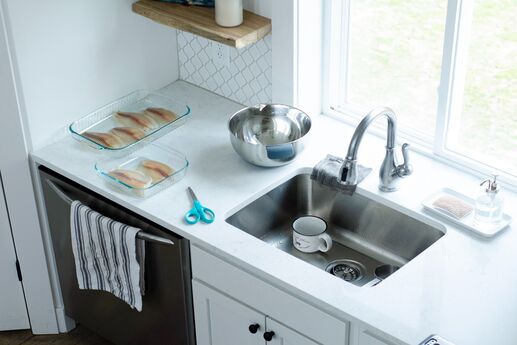Kitchen Faucet Buyers Guide
When it comes to buying a kitchen faucet, narrow the "spraying field" by identifying the style you want, the function you need and the budget you have.
The kitchen faucet is one of the most hardworking fixtures in your house. It’s the central hand-washing station and dish-rinsing hub, and the occasional makeshift bath for baby. With a flick of the wrist or a gentle touch, it enables food preparation, cleanliness or a drink of water in your home’s busiest multipurpose room. “The faucet has become the ultimate accessory in the kitchen arena,” says Tracy Morris, an interior designer based in Washington, D.C., who has a modern flair with classic design. Faucet style isn’t as fickle as fashion, yet industrial designers keep dressing up this kitchen basic with innovative lifestyle-enhancing technology. Built to serve and designed to appeal, the average-quality faucet lasts about 10 years.
Here are some practical guidelines for choosing a kitchen faucet:
STYLE
“We’re still drawn by the eyes, and at the end of the day the aesthetics have to work for us,” says Paul Anater, kitchen designer and editor of Kitchen and Residential Design. When it comes to the look of a faucet, focus on configuration, shape and finish.
- Configuration relates to the number of holes -- typically one to four along the sink or wall -- that accommodate the faucet’s parts. A one-hole configuration offers an uncluttered, clean look and suits a faucet with an attached lever. Conversely, a bridge-style faucet with a side spray requires three or four holes. If you are replacing a faucet rather than beginning new construction, avoid the need for more holes by choosing a faucet that has the same configuration or fewer holes than your old model. An escutcheon neatly masks any holes that are no longer needed.
- Shape defines a faucet’s silhouette. Some shapes make a grand statement; others remain relatively anonymous. In general, square and angular faucets with sleek proportions compliment contemporary kitchens, and curved models with heartier spouts and Victorian/nostalgic styling go with traditional. Goosenecks and low-arc faucets are compatible with most design schemes.
- Finish, here, refers to the color of the faucet. “The faucet finish does not have to match with the cabinet hardware,” says Morris. She often mixes brushed nickel with chrome or rubbed bronze, but will not mix brass and chrome. When in doubt, a safe and stylish suggestion is to stay within the same metallic family.
FUNCTIONALITY
Product designers tweak faucet features and invent technologies that make kitchen sink tasks more user-friendly and less stressful. When comparing how a faucet works, look at how water turns on and off and how maneuverable the spout is.
- On/Off: Touch faucets activate the stream of water with a simple nudge from the back of the hand, forearm, elbow, or whatever body part isn’t covered in a greasy mess. This is a life-altering feature that benefits neat freaks, parents of sticky-fingered children, and seniors or people with disabilities who may not have the hand control or strength to operate an ordinary handle. While touch is out of reach for some budgets, classic levers and handled faucets are at every price range and require one or two hands to operate.
- Spouts: The shape and size of a kitchen faucet’s spout contribute to its capability. A spout should fit proportionately with the sink so it reaches more areas of the basin when it swivels. Also, a spout with a high arc allows tall pots or vases to be filled easily.
- Pull-downs: Pull-down faucets increase flexibility at the sink by enabling the user to pull down the nozzle, extend the reach of the water and direct its flow. The pull-down sprayer often features a toggle to control water flow. Maribeth Kwasniewski, Moen’s senior product designer for kitchens, says pull-downs are the largest-growing segment of the market. Try out some of the mechanisms for pulling down and putting back. A magnetic docking mechanism helps assure the faucet is returned to its original position securely.
DURABILITY
Says Dave Braden, operations manager at Joe Hillman Plumbers of South Florida: “Most faucets we repair are the cheaper off-brand models. So stick with popular names and don’t be afraid to spend.” He also says that it is much easier to get replacement parts from American faucet companies. Faucets are also under limited warranty.
- Ceramic disc valves typically ward against leaks for a decade. Considering the amount of use and abuse, quality faucets equipped with industry standard ceramic disc valves require little maintenance. Delta’s proprietary diamond dust valves never have to be lubricated and are designed to last about 30 years. Faucet-makers also offer limited lifetime warranties on many faucets.
- Protective finishes -- such as polyvinyl butyral (PVB), a strong, flexible resin -- built into the colorful coat prevent corrosion, tarnish and scratches and keep your faucet looking good. Specialty finishes like Moen’s Spot Resist are devised to keep stainless and brushed nickel faucets free of fingerprints and water spots.
CONSERVATION AND ENERGY EFFICIENCY
If conserving water and saving energy and money interest you, look for faucets that operate at a 1.5 gallon per minute (GPM) flow. Right now, many faucets operate at 2.0 to 2.2 GPM. Seek out a model with a lower GPM and positive performance reviews.



